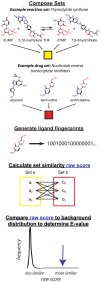A mapping of drug space from the viewpoint of small molecule metabolism
- PMID: 19701464
- PMCID: PMC2727484
- DOI: 10.1371/journal.pcbi.1000474
A mapping of drug space from the viewpoint of small molecule metabolism
Abstract
Small molecule drugs target many core metabolic enzymes in humans and pathogens, often mimicking endogenous ligands. The effects may be therapeutic or toxic, but are frequently unexpected. A large-scale mapping of the intersection between drugs and metabolism is needed to better guide drug discovery. To map the intersection between drugs and metabolism, we have grouped drugs and metabolites by their associated targets and enzymes using ligand-based set signatures created to quantify their degree of similarity in chemical space. The results reveal the chemical space that has been explored for metabolic targets, where successful drugs have been found, and what novel territory remains. To aid other researchers in their drug discovery efforts, we have created an online resource of interactive maps linking drugs to metabolism. These maps predict the "effect space" comprising likely target enzymes for each of the 246 MDDR drug classes in humans. The online resource also provides species-specific interactive drug-metabolism maps for each of the 385 model organisms and pathogens in the BioCyc database collection. Chemical similarity links between drugs and metabolites predict potential toxicity, suggest routes of metabolism, and reveal drug polypharmacology. The metabolic maps enable interactive navigation of the vast biological data on potential metabolic drug targets and the drug chemistry currently available to prosecute those targets. Thus, this work provides a large-scale approach to ligand-based prediction of drug action in small molecule metabolism.
Conflict of interest statement
The authors have declared that no competing interests exist.
Figures






Similar articles
-
Metabolic pathway analysis approach: identification of novel therapeutic target against methicillin resistant Staphylococcus aureus.Gene. 2015 Feb 10;556(2):213-26. doi: 10.1016/j.gene.2014.11.056. Epub 2014 Nov 28. Gene. 2015. PMID: 25436466
-
Global mapping of pharmacological space.Nat Biotechnol. 2006 Jul;24(7):805-15. doi: 10.1038/nbt1228. Nat Biotechnol. 2006. PMID: 16841068
-
Detecting drug targets with minimum side effects in metabolic networks.IET Syst Biol. 2009 Nov;3(6):523-33. doi: 10.1049/iet-syb.2008.0166. IET Syst Biol. 2009. PMID: 19947778
-
Computational approaches to predict drug metabolism.Expert Opin Drug Metab Toxicol. 2009 Jan;5(1):15-27. doi: 10.1517/17425250802568009. Expert Opin Drug Metab Toxicol. 2009. PMID: 19236226 Review.
-
Investigating drug-target association and dissociation mechanisms using metadynamics-based algorithms.Acc Chem Res. 2015 Feb 17;48(2):277-85. doi: 10.1021/ar500356n. Epub 2014 Dec 12. Acc Chem Res. 2015. PMID: 25496113 Review.
Cited by
-
Curation and analysis of multitargeting agents for polypharmacological modeling.J Chem Inf Model. 2014 Sep 22;54(9):2536-43. doi: 10.1021/ci500092j. Epub 2014 Aug 29. J Chem Inf Model. 2014. PMID: 25133604 Free PMC article.
-
Toward mechanistic classification of enzyme functions.Curr Opin Chem Biol. 2011 Jun;15(3):435-42. doi: 10.1016/j.cbpa.2011.03.008. Epub 2011 Apr 12. Curr Opin Chem Biol. 2011. PMID: 21489855 Free PMC article. Review.
-
Structure and dynamics of molecular networks: a novel paradigm of drug discovery: a comprehensive review.Pharmacol Ther. 2013 Jun;138(3):333-408. doi: 10.1016/j.pharmthera.2013.01.016. Epub 2013 Feb 4. Pharmacol Ther. 2013. PMID: 23384594 Free PMC article. Review.
-
Polypharmacology: drug discovery for the future.Expert Rev Clin Pharmacol. 2013 Jan;6(1):41-7. doi: 10.1586/ecp.12.74. Expert Rev Clin Pharmacol. 2013. PMID: 23272792 Free PMC article. Review.
-
A Computational Approach Using Bioinformatics to Screening Drug Targets for Leishmania infantum Species.Evid Based Complement Alternat Med. 2018 Mar 28;2018:6813467. doi: 10.1155/2018/6813467. eCollection 2018. Evid Based Complement Alternat Med. 2018. PMID: 29785196 Free PMC article.
References
-
- Johnson M, Lajiness M, Maggiora G. Molecular similarity: a basis for designing drug screening programs. Prog Clin Biol Res. 1989;291:167–171. - PubMed
-
- Payne DJ, Gwynn MN, Holmes DJ, Pompliano DL. Drugs for bad bugs: confronting the challenges of antibacterial discovery. Nat Rev Drug Discov. 2007;6:29–40. - PubMed
-
- Kramer JA, Sagartz JE, Morris DL. The application of discovery toxicology and pathology towards the design of safer pharmaceutical lead candidates. Nat Rev Drug Discov. 2007;6:636–649. - PubMed
-
- Drews J. Case histories, magic bullets and the state of drug discovery. Nat Rev Drug Discov. 2006;5:635–640. - PubMed
-
- Paolini GV, Shapland RH, van Hoorn WP, Mason JS, Hopkins AL. Global mapping of pharmacological space. Nat Biotechnol. 2006;24:805–815. - PubMed
Publication types
MeSH terms
Substances
Grants and funding
LinkOut - more resources
Full Text Sources
Other Literature Sources
Medical

